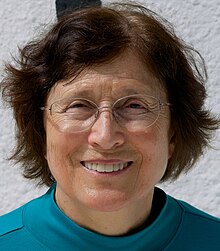Renata Kallosh
Renata Kallosh | |
|---|---|
 | |
| Born | January 16, 1943 Chernivtsi, Ukrainian SSR, Soviet Union |
| Alma mater | Moscow State University |
| Known for | Work on supergravity, string theory and inflationary cosmology KKLT mechanism |
| Spouse | Andrei Linde |
| Scientific career | |
| Fields | Theoretical physics |
| Institutions | Lebedev Physical Institute CERN Stanford University |
Renata Elizaveta Kallosh (Russian: Рената Елизавета (Эрнестовна) Каллош; Ukrainian: Рената Єлизавета Каллош; born 1943) is a Russian-American theoretical physicist. She is a professor of physics at Stanford University, working there on supergravity, string theory and inflationary cosmology.
Biography
[edit]Born in 1943 in Chernivitsi in the former capital of Bukovina, in the former Austro-Hungarian Empire. (Kallosh is a hungarian family name and others from her home town bear the name, e g Sándor Kallós.) She completed her Bachelor's from Moscow State University in 1966 and obtained her Ph.D. from Lebedev Physical Institute, Moscow in 1968. She was then a professor at the same institute, before moving to CERN for a year in 1989. Kallosh joined Stanford in 1990 and continues to work there.[1] In 2009 she received the Lise Meitner Award of the Gothenburg University.[2] In 2014 awarded Doctorate Honoris Causa of the University of Groningen. In 2017 she was awarded Lorentz Chair position at the University of Leiden,[3] and became a member of the American Academy of Arts and Sciences.[4]
Kallosh is best known for her contributions to the theory of supergravity – the supersymmetric generalization of Einstein's theory of gravity. She was the first to quantize supergravity, obtaining the full set of Feynman rules including a new, unexpected ghost particle (now called the Nielsen-Kallosh ghost).[5][6] This paper also gave one of the first applications of BRST symmetry[7][8] to express the gauge invariances of gravity, and, incidentally, introduced the name "BRST". She also was the first to understand the structure of divergences in quantum theories of supergravity, showing, among other results, that supergravity with N=8 supersymmetry is finite at least up to 8 loops.[9] She is the author of many papers on black hole solutions in supergravity theories. A particularly influential work is the recognition, in collaboration with Sergio Ferrara, that black hole solutions with higher supersymmetry correspond to attractor solutions of analogue mechanical systems.[10]
Kallosh is also known[11] for her contributions to string theory. In particular, she, along with Sandip Trivedi, Andrei Linde, and Shamit Kachru, found the mechanism to stabilize string theory vacua[12] referred to as KKLT mechanism after the authors' last names. This mechanism provided a possible theoretical explanation of the anomalously small value of vacuum energy (cosmological constant), and a description of the present stage of the accelerated expansion of the universe in the context of the theory of inflationary multiverse[13] and string theory landscape.[14]
After the discovery of the KKLT mechanism, her interests shifted towards investigation of cosmological implications of supergravity and string theory. In particular, Renata Kallosh and Andrei Linde, together with their collaborators, developed a theory of cosmological attractors. This is a broad class of versions of inflationary cosmology which provide one of the best fits to the latest observational data.[15]
References
[edit]- ^ "Renata Kallosh -- Stanford Physics Department Faculty Listing". Retrieved 27 December 2019.
- ^ "Gothenburg Lise Meitner Award". Retrieved 27 December 2019.
- ^ "Lorentz Chair". Retrieved 27 December 2019.
- ^ "Renata Kallosh". American Academy of Arts and Sciences. Retrieved 27 December 2019.
- ^ Kallosh, Renata (1978). "Modified Feynman rules in supergravity". Nuclear Physics B. 141 (1–2): 141–152. Bibcode:1978NuPhB.141..141K. doi:10.1016/0550-3213(78)90340-1. ISSN 0550-3213.
- ^ Nielsen, Niels (1978). "Ghost counting in supergravity". Nuclear Physics B. 140 (3): 449. Bibcode:1978NuPhB.140..449K. doi:10.1016/0550-3213(78)90009-3.
- ^ Becchi, C.; Rouet, A.; Stora, Raymond (1976). "Renormalization of gauge theories". Annals of Physics. 98 (2): 287. Bibcode:1976AnPhy..98..287B. doi:10.1016/0003-4916(76)90156-1.
- ^ Tyutin, Igor V. (1975). "Gauge invariance in field theory and statistical physics in operator formalism". Lebedev Institute Report. 39.
- ^ Kallosh, Renata (1981). "Counterterms in extended supergravity". Physics Letters B. 99 (2): 122. Bibcode:1981PhLB...99..122K. doi:10.1016/0370-2693(81)90964-3.
- ^ Ferrara, Sergio; Kallosh, Renata (1996). "Supersymmetry and attractors". Physical Review D. 54 (2): 1514–1524. arXiv:hep-th/9602136. Bibcode:1996PhRvD..54.1514F. doi:10.1103/PhysRevD.54.1514. PMID 10020825. S2CID 5137358.
- ^ "INSPIRE Citations Summary for Author "kallosh,renata"". Retrieved 13 May 2018.
- ^ Kachru, Shamit; Kallosh, Renata; Linde, Andrei; Trivedi, Sandip P. (2003). "de Sitter Vacua in String Theory". Physical Review D. 68 (4): 046005. arXiv:hep-th/0301240. Bibcode:2003PhRvD..68d6005K. doi:10.1103/PhysRevD.68.046005. S2CID 119482182.
- ^ Linde, Andrei (2015). "de Sitter Vacua in String Theory". Reports on Progress in Physics. 80 (2): 022001. arXiv:1512.01203. Bibcode:2015arXiv151201203L. doi:10.1088/1361-6633/aa50e4. PMID 28071600. S2CID 5221573.
- ^ Susskind, Leonard (2005). The Cosmic Landscape: String Theory and the Illusion of Intelligent Design (Publisher: Little, Brown and Company). Little, Brown and Company. ISBN 9780316155793.
- ^ Ade, P.A.R.; et al. (2016). "Planck 2015 results. XX. Constraints on inflation". Astronomy and Astrophysics. 594 (A20): A20. arXiv:1502.02114. Bibcode:2016A&A...594A..20P. doi:10.1051/0004-6361/201525898. S2CID 119284788.
External links
[edit]- Renata Kallosh publications indexed by Google Scholar
- Renata Kallosh's Home Page at Stanford
- Renata Kallosh on INSPIRE-HEP
- 1943 births
- Living people
- American string theorists
- Russian women physicists
- American women physicists
- Moscow State University alumni
- Stanford University Department of Physics faculty
- Fellows of the American Academy of Arts and Sciences
- People associated with CERN
- 21st-century American physicists
- 20th-century Russian physicists
- 20th-century Russian women scientists
- 21st-century American women scientists
